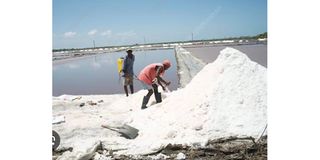Prime
Kilwa salt farms: Tanzania's unlikely tourist attraction on the rise

What you need to know:
- The pristine white sandy beaches now have opened their doors for tourists who are intrigued by the traditional salt farms stationed near the mangroves
Kilwa has always been vital in the East African economy. Located on the southern coast of Tanzania, Kilwa was once a vibrant trading town, a Swahili coast handling the commerce networking Middle East, India, and East Africa.
Now a Unesco World Heritage site, Kilwa has emerged as a popular destination for tourists, and those fascinated with its rich history.
The pristine white sandy beaches now have opened their doors for tourists who are intrigued by the traditional salt farms stationed near the mangroves.
The farmers still use the ancient methods of harvesting the salt. Located not far from Kilwa Masoko, the farms are open to tourists who can easily gain access to them on foot.
Tour operators have been quick to add the visits to their tourists’ itineraries.
The spike in tourism visits to these salt farms has reignited talks about the once prominent coastal town. Salt farming has been the cornerstone for centuries.
Local farmers are more than willing to share their salt extraction methods and rich history.
With more than 36 salt farmers, visitors have more than enough sites to visit and learn of the Swahili trade that is engrained in this world heritage site.
The proximity to the salt farms has been a key factor in the frequent visits. Just 10 minutes from Kilwa Masoko the clear view of the crystal white salt hills appears, with farmers shoving the salt trapped in the ocean water.
The insight into the local salt production is thrilling, the skills passed down generations within these local communities, one of the entrepreneurship that made Kilwa one of the wealthiest towns in the 14th century.
What was once a purely economic activity has now morphed into a new tourist frenzy.
The tourist visits have also spurred economic benefits within the local communities while also promoting their traditional practices.
The seawater collection is still being done by using the small pans.
Farmers spend hours gathering the water that gradually evaporates all the water under the scratching hot sun leaving behind the salt crystals.
The tourists get to watch the farmers rake the salt into piles before further evaporation takes place.
The salt is then collected, packed, and shipped. The salt-making art has been practiced for generations and the farmers are eager to share it with tourists.
The Kilwa people are known for their warmth and hospitality and are eager to share their stories of the challenges of global warming, the market, and how their business has survived many years as the world and technology evolve.
In contrast to the large-scale industrial salt production, the traditional handcrafted technique used in Kilwa utilises no chemicals in the process of making the salt, preserving its minerals and purity.
These Kilwa salt farms are mostly family-run or small incorporated, making all the profits made remain within the community to improve its livelihood.
Kilwa salt is known for its richness in minerals, unlike refined table salt, making their salt richer, more flavourful, and preferred.
Under the blue skies overlooking the sandy beaches, the salt farms are located in breathtaking views, which will have visitors not only watch the salt-making process but also set their eyes on the stunning mangroves and coastal lagoons.
The farmers have been incorporated into the mangrove conservation efforts, allowing the locals to make a living while protecting the environment.
The mangroves that help protect soil erosion and are fish breeding grounds play a crucial role in maintaining the local ecosystem.
They have been able to achieve a balance between salt farming and protecting the environment.
Salt farming is visibly a daunting task.
Local farmers are more than willing to let tourists get the hands-on experience by raking the salt piles or any part of the procedure that can make them appreciate the efforts they put in for the pints of salts we enjoy in our daily meals.
Tourists can also buy the preferred salt on-site, with some farms allowing them to taste the salt and choose the flavour you prefer.
The ancient town has been around for thousands of years, with its population made of three Bantu tribes that coexisted harmoniously, the Matumbi, Mwela, and Machinga people.
Unlike the most celebrated and famous tourist sites in Tanzania, Kilwa remained unaffected by mass tourism and is ideal for off-the-beat adventure seekers, who also enjoy quiet off-the-grid moments.
This hidden gem boasts of its beautiful, unspoiled beaches with sea turtles and dolphins easily visible to visitors.
The waters are also favourable for snorkeling and diving. The marine life is abundant in the Kilwa archipelago waters,
A stone's throw away from the salt farms tourists are spoilt with choices with plenty of attractions.
They can visit the Kilwa Kisiwani Ruins of the ancient Swahili trading hub and the local fish market, where fish is sold at very affordable prices fresh from the ocean.
Tourists can also watch the fishermen scoop the fish off the water and roast it for them as they wait.
The Kilwa Masoko beach is one of the best relaxing places. The tranquil sandy beaches are accessible to all and the breeze will take away all the stress from the busy urban life.
Kilwa’s tourism advantage also lies in its affordability, from accommodation to food and fees to the tourist sites.
The strong historical and cultural significance of this town can not be overstated.
The German, English, Arab, Indian and Swahili people can find a trace of their history in this age-old town that is still striving today.
Kilwa residents are willing to welcome tourists with open hands and share the oral knowledge they have amassed through generations.



